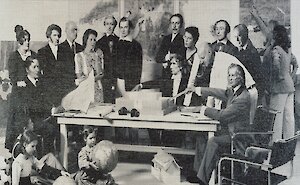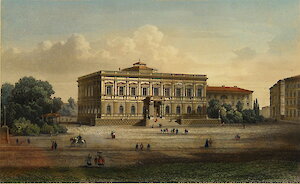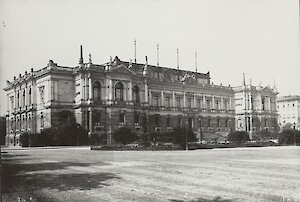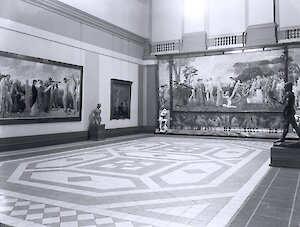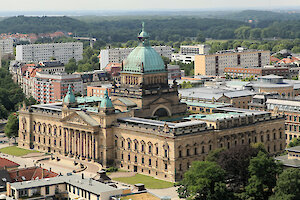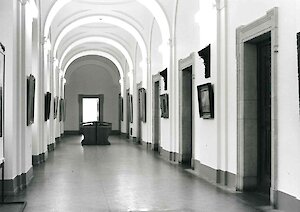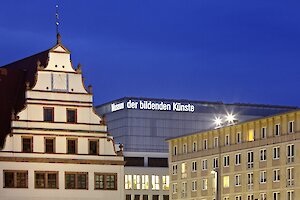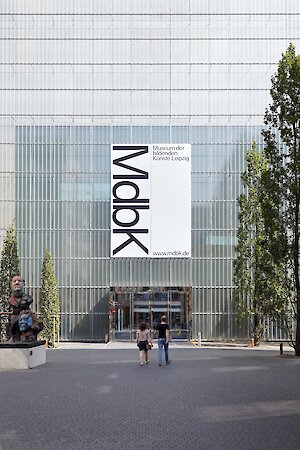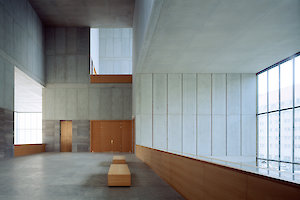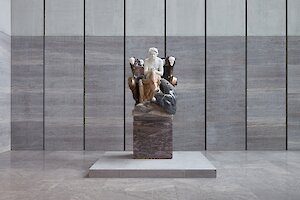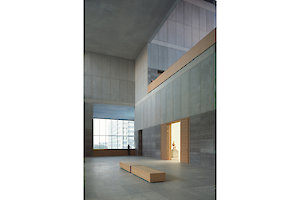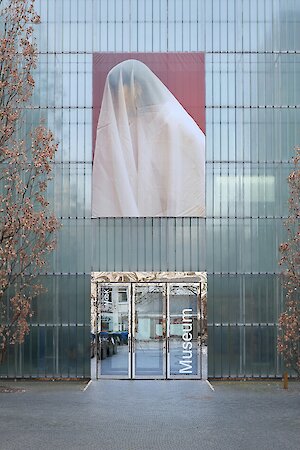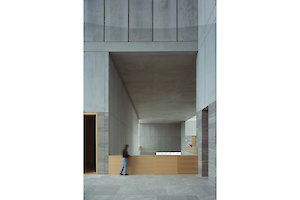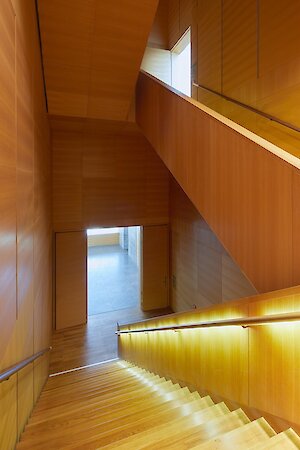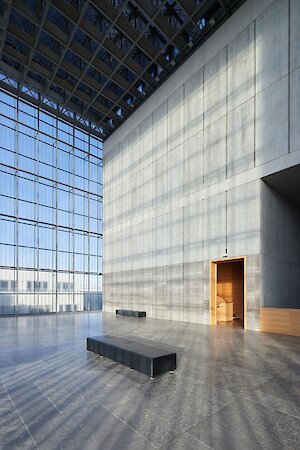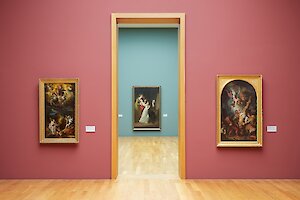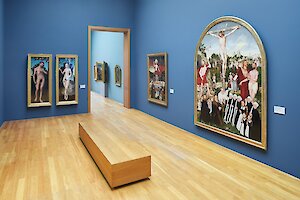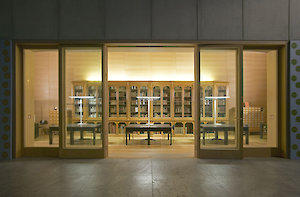Museum
The MdbK encourages people to connect – with other people, with their own surroundings, and with art. We create spaces for exchange and contemplation – for thinking, laughing, remembering, debating, lingering, researching, designing, learning, questioning and enjoying.
Mission Statement
The Museum der bildenden Künste Leipzig encourages people to connect – with other people, with their own surroundings, and with art. We create spaces for exchange and contemplation – for thinking, laughing, remembering, debating, lingering, researching, designing, learning, questioning and enjoying.
inviting
The MdbK is an authentic place for sensory experiences. Art works promote discourse, interaction and education. With its open architecture, with its courtyards and permanent exhibition areas that are accessible free of charge, the museum offers a multifaceted society the preconditions for meeting, taking time out and sharing (new) knowledge. Participatory programmes, events and exhibitions are the basis for our institution and for inviting participation. We recognize each individual’s different background in life, knowledge and experience as expertise in its own right and we consider this an enrichment.
diverse
The MdbK positions itself as an inclusive, accessible and anti-discriminatory museum. In our programmes, we bring different generations into dialogue and offer space for marginalized perspectives. Together with diverse interest groups, we continue to develop our anti-discrimination activities, particularly with regard to gender equality, transnationality and inclusion. We are committed to strengthening diversity within our collection.
inspiring
The museum collection comprises works from seven centuries, predominantly from European art history. A focus is on art from the 20th and 21st centuries from Leipzig and on its place in an international context. We are intensively engaged with the collection in its development through history, including its gaps, and we critically examine contexts of injustice. Our events, exhibitions and research are linked to this. At the same time, we are developing formats for active participation that deal with socially relevant topics.
reliable
With professionalism and a sense of responsibility, we pursue the museum tasks defined by ICOM (Prague, 24 August 22). In addition, the MdbK is a municipal institution that is engaged in the implementation of the strategic objectives and guidelines formulated by the city council. As an educational institution, the museum connects with other institutions and seeks external expertise. At the same time, we see ourselves as a team of experts and seek to make our work and decision-making processes transparent. The MdbK supports the idea of open access and aims at enabling public access to the collection and institutional knowledge. Thus we use digital and analogue media in communicating our projects.
engaged
We live by fundamental democratic values. The appreciation of people, cultural assets and resources determines our actions both inwardly and outwardly. Together with other actors and visitors, we participate in social transformation processes. We use our resources of staff, time and material wisely. We are mindful of sustainability and quality. Fairness, pleasure, openness and creativity are important aspects of our daily work. We seek to deal with errors constructively and to grow continually. The MdbK is an institution that values self-critique and learning.
living
We understand art as the intellectual and cultural heritage of humankind and are convinced of the relevance of the museum as a non-profit, public space in a diverse (urban) society. We would like to shape the MdbK for future generations in a lively and responsible manner. We warmly welcome anyone interested to join us.
History
The MdbK is one of the oldest art museums in Germany and can be traced back to the bourgeoisie's passion for collecting art in the 19th century. One of the outstanding art collectors was Maximilan Speck von Sternburg, who amassed a treasure trove of paintings while travelling in Europe. He was one of the founding members of the Leipzig Art Association, which was established in 1837 with the aim of amassing an art collection. After the "Städtisches Museum" was established in the Erste Bürgerschule in 1848, the art collection moved into a new building on Augustusplatz in 1858. The building was made possible by the legacy of Adolf Heinrich Schletter, who had bequeathed considerable assets and his collection of French art to the city in 1853. The prominent location on the city's largest public square emphasises the appreciation of Leipzig's citizens.
While the Kunstverein acquired contemporary art from the outset, works by Old Masters were also added to the art collection from private and municipal collections. Over the course of the 19th century, the collection continued to grow through further donations, endowments and bequests, making an extension necessary. Once again, it was a Leipzig citizen who made it possible: with funds from the merchant Dominic Grassi and according to the plans of the city planning officer Hugo Licht, the museum was extended by two wings in 1886.
The MdbK dominated Augustusplatz like a palace complex.
The museum building fell victim to a bomb attack in 1943. From 1952 to 1997, the MdbK was provisionally housed in the former Reichsgericht, which is now home to the Federal Administrative Court. In 1996, Leipzig City Council decided to rebuild the MdbK on Sachsenplatz. The topping-out ceremony was celebrated on 30 April 2001 and on 4 December 2004 - exactly 61 years after the destruction of the old museum - the new MdbK was opened.
Architecture
Designed by Berlin architects Hufnagel / Pütz / Rafaelian, the 36-meter high glass cube peeks out of the surrounding structures. Courtyards and terraces surround the museum complex and blend into the city through adoption of the architectural style of the Leipzig passages. The generosity of space inside is uniquely defined through its play with different visual axes and an outlook onto the urban landscape. The material fusion of glass, concrete, limestone and oak mark the interior, endowing it with a vibrant appeal. The presentation of contemporary artworks and installations that are integrated into the design of our corridors, terraces, and courtyards demonstrate a skilful meeting of art and architecture.
Library
The MdbK has a reference library with free access for everyone. Staff is always available to assist you with the use of our resources. If you wish to conduct extensive research in our library, please give us a call beforehand.
One of Germany’s largest museum libraries, our art historical collection comprises 100.000 items. The library’s origination dates back to the year 1837, when citizens of Leipzig founded the local art society, which would later also be responsible for the establishment of our museum. Our library is oriented towards suiting the museum’s collections, and draws contemporary literature about art from regional and international circles. A particular focus is set on art and culture from a time span between the 17th and the 19th century. Important source material for art historical literature ranges from guides about European art centers to contemporary monographs and a unique collection of rare exhibition catalogues. The library holds international collections catalogues, as well.
The library is open on Wednesdays from 1 to 4 p.m. and by appointment (T: +49 341 216 999 56, M: sebastian.stumpe@leipzig.de).
Contact
Team MdbK
Dr. Jeannette Stoschek, Deputy Director, Head of Collections
Gabriele Pätow, Secretary to the Director
+49 341 216 999 20
gabriele.paetow@leipzig.de
Dr. Sabine Hoffmann, Academic Assistant to the Director
+49 341 216 999 19
sabine.hoffmann@leipzig.de
Dr. Sylva Dörfer, Head of Communication and Participation
+49 341 216 999 50
sylva.doerfer@leipzig.de
MdbK [in transit]
Sithara Weeratunga, Agent for Diversity / 360° - Programme of the German Federal Cultural Foundation
+49 341 216 999 51
sithara.weeratunga@leipzig.de
Olga Vostretsova, Agent for Diversity / 360° - Programme of the German Federal Cultural Foundation
+49 341 216 999 63
olga.vostretsova@leipzig.de
Collections
Dr. Jeannette Stoschek, Head of Graphic Collection
+49 341 216 999 40
jeannette.stoschek@leipzig.de
Dr. Jan Nicolaisen, Head of Painting and Sculpture
+49 341 216 999 45
jan.nicolaisen@leipzig.de
Dr. Marcus Andrew Hurttig, Curator of Painting 20th and 21st Century, 21st Century in drawings and prints
+49 341 216 999 17
marcus.hurttig@leipzig.de
Dr. Philipp Freytag, Curator Photography and Media Arts
+49 341 216 999 64
philipp.freytag@leipzig.de
Dr. Ulrike Saß, Provenance Research
+49 341 216 999 62
ulrike.sass@leipzig.de
Susanne Petri, Research Assistant, Documentation and Graphic 20th Century
+49 341 216 999 12
susanne.petri@leipzig.de
Sabine Schmidt, Staff member for Digitalisation, Reproductions and Digital Documentation
+49 341 216 999 18
sabine.schmidt@leipzig.de
Linda Wagner, Loan Management & Collection Registry
+49 341 216 999 28
registrars.mdbk@leipzig.de
Ulrike Milde, Loan Management & Collection Registry
+49 341 216 998 23
registrars.mdbk@leipzig.de
Marko Kloss, Collection Manager
+49 341 216 999 44
marko.kloss@leipzig.de
Uwe Wagner, Collection Manager
+49 341 216 999 31
uwe.wagner@leipzig.de
Aurelia Rager, Assistant Curator
+49 341 216 999 35
aurelia.rager@leipzig.de
Louise Charlotte Schmidt, Assistant Curator
+49 341 216 999 29
louisecharlotte.schmidt@leipzig.de
Restoration
Rüdiger Beck, Head
+49 341 216 999 25
ruediger.beck@leipzig.de
Antje Hake, Paintings Conservator
+49 341 216 999 61
antje.hake@leipzig.de
Sarah Storz, Paper Conservator
+49 341 216 999 22
sarah.storz@leipzig.de
Library & Artist Archive
Sebastian Stumpe, Librarian
+49 341 216 999 56
sebastian.stumpe@leipzig.de
External Collections / EVELYN RICHTER & URSULA ARNOLD ARCHIV of the Ostdeutsche Sparkassenstiftung
Art Education
Carolin Rothmund, Head
+49 341 216 999 27
carolin.rothmund@leipzig.de
Hermine Brietzel, Art Mediator (on parental leave)
+49 341 216 999 49
hermine.brietzel@leipzig.de
Kirsten Lemm, Art Mediator
+49 341 216 999 58
kirsten.lemm@leipzig.de
Anna Jäger, Art Mediator, Booking Service
+49 341 216 999 23
anna.jaeger@leipzig.de
Julia Bröker, Scientific Trainee
+49 341 216 999 43
julia.broeker@leipzig.de
Public Relations, Marketing & Event
Jörg Dittmer, Head
+49 341 216 999 42
joerg.dittmer@leipzig.de
Sonja Lucia Gatterwe, Press and Online Communication
+ 49 341 216 999 26
sonjalucia.gatterwe@leipzig.de
Dirk Kuntze, New Media
+ 49 341 216 995 30
dirk.kuntze@leipzig.de
Ulrike Otto, Press and Visitor Services
+ 49 341 216 999 14
ulrike.otto@leipzig.de
Lena Dahlberg, Scientific Trainee
+ 49 341 216 999 34
lena.dahlberg@leipzig.de
Fundraising & Rentals
Katrin Siegmeyer, Employee
+49 341 216 999 47
katrin.siegmeyer@leipzig.de
Administration
Anne-Kathrin Herrmann, Head
+49 341 216 999 15
anne-kathrin.herrmann@leipzig.de
Janet Schirmer, Clerkess/ Museum shop
+49 341 216 999 36
janet.schirmer@leipzig.de
Tim Sachse, Sachbearbeiter/Museumsshop
+49 341 216 999 16
tim.sachse@leipzig.de
Security & Facility Management
Torsten Cech, Head
+49 341 216 999 30, Mobil: +49 175 2088018
torsten.cech@leipzig.de
Sven Hottenrott, Museum Carpenter
+49 341 216 999 38
sven.hottenrott@leipzig.de
Karsten Hummel, Building Services
+49 341 216 999 39
karsten.hummel@leipzig.de
Dennis Kuhn, Haustechniker
+49 341 216 999 39
dennis.kuhn@leipzig.de
Jens Wuttke, Techniker haustechnische Anlagen
+49 341 216 99 969
jens.wuttke@leipzig.de

